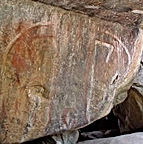
Elk Mound
Bigfoot Research Center

Almasty
The Almas or Alma (Mongolian: Алмас/Almas, Bulgarian: Алмас, Chechen: Алмазы, Turkish: Albıs), Mongolian for "wild man", is a purported hominid cryptozoological species reputed to inhabit the Caucasus and Pamir Mountains of central Asia, and the Altai Mountains of southern Mongolia. The creature is not currently recognized or cataloged by science. Furthermore, scientists generally reject the possibility that such megafauna cryptids exist, because of the improbably large numbers necessary to maintain a breeding population.
Description
Almas is a singular word in Mongolian; the properly formed Turkic plural would b'almaslar'. As is typical of similar legendary creatures throughout Central Asia, Russia, Pakistan and the Caucasus, the Almas is generally considered to be more akin to "wild people" in appearance and habits than to apes (in contrast to the Yeti of the Himalayas).
Almases are typically described as human-like bipedal animals, between five and six and a half feet tall, their bodies covered with reddish-brown hair, with anthropomorphic facial features including a pronounced browridge, flat nose, and a weak chin. Many cryptozoologists believe there is a similarity between these descriptions and modern reconstructions of how Neanderthals might have appeared.
Evidence
Speculation that Almases may be something other than legendary creatures is based on purported eyewitness accounts, alleged footprint finds, and interpretations of long-standing native traditions that have been anthropologically collected.
Folk tales
Almases appear in the legends of local people, who tell stories of sightings and human-Almas interactions dating back several hundred years.
Drawings interpreted as Almas also appear in a Tibetan medicinal book. British anthropologist Myra Shackley noted that "The book contains thousands of illustrations of various classes of animals (reptiles, mammals and amphibia), but not one single mythological animal such as are known from similar medieval European books. All the creatures are living and observable today."
Famous sightings
Sightings recorded in writing go as far back as the 15th century.
In 1420, Hans Schiltberger recorded his personal observation of these creatures in the journal of his trip to Mongolia as a prisoner of the Mongol Khan. Schiltberger also recorded one of the first European sightings of Przewalski horses. (Manuscript in the Munich Municipal Library. He noted that Almasty are part of the Mongolian and Tibetan apothecary's materia medica, along with thousands of other animals and plants that live today.
British anthropologist Myra Shackley in Still Living? describes Ivan Ivlov's 1963 observation of a family group of Almas. Ivlov, a pediatrician, decided to interview some of the Mongolian children who were his patients, and discovered that many of them had also said that they had seen Almases and that neither the Mongol children nor the young Almas were afraid of each other. Ivlov's driver also claimed to have seen them.
Alleged captive Almas
A wildwoman named Zana is said to have lived in the isolated mountain village of T'khina fifty miles from Sukhumi in Abkhazia in the Caucasus; some have speculated she may have been an Almas, but the evidence indicates that she was a human.
Captured in the mountains in 1850, she was at first violent towards her captors but soon became domesticated and assisted with simple household chores. Zana is said to have had sexual relations with a man of the village named Edgi Genaba, and gave birth to a number of children of apparently normal human appearance. Several of these children, however, died in infancy.
The father, meanwhile, gave away four of the surviving children to local families. The two boys, Dzhanda and Khwit Genaba (born 1878 and 1884), and the two girls, Kodzhanar and Gamasa Genaba (born 1880 and 1882), were assimilated into normal society, married, and had families of their own. Zana herself died in 1890. The skull of Khwit (also spelled Kvit) is still extant, and was examined by Grover Krantz in the early 1990s. He pronounced it to be entirely modern, with no Neanderthal features at all. Another account by Russian anthropologist M.A.Kolodieva described the skull as significantly different from the normal males from Abkhazia: the skull "approaches closest the Neolithic Vovnigi II skulls of the fossil series".
In the 2013 Channel 4 documentary, Bigfoot Files, Bryan Sykes of the University of Oxford showed that Zana's DNA was 100% Sub-Saharan African in origin and she could have been a slave brought to Abkhazia by the Ottoman Empire Sykes however raised questions as to whether Zana could have been from a population of Africans who left the continent tens of thousands of years earlier as her son, Khwit's skull had some unique and archaic characteristics. It should be noted that Sykes only looked at the mtDNA, that is only the DNA from the maternal side. He did not look at the nuDNA from her paternal lineage so the often stated claim that Zana was 100% Sub-Saharan African is an inaccurate conclusion because the DNA tests were limited.
In 2015, Sykes reported that he had undertaken DNA tests on saliva samples of six of Zana's living relatives and a tooth of her deceased son Khwit and concluded that Zana was 100% African but not of any known group, refuting the theory that she was a runaway Ottoman slave. Rather, he believes her ancestors left Africa approximately 100,000 years ago and lived in the remote Caucasus for many generations.
Another case is said to date from around 1941, shortly after the German invasion of the USSR. A "wild man" was captured somewhere in the Caucasus by a detachment of the Red Army. He appeared human, but was covered in fine, dark hair. Interrogation revealed his apparent inability (or unwillingness) to speak, and the unfortunate creature is said to have been shot as a German spy. There are various versions of this legend in the cryptozoological literature and hard proof is absent.
From Wikipedia